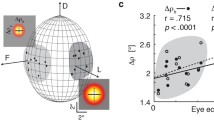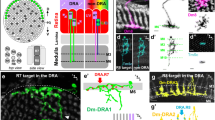Summary
-
1.
The spectral, polarizational and angular sensitivities of photoreceptor cells In the honeybee compound eye are examined by intracellular electrophysiological recordings. The specific aim of this paper is to compare the characteristics of receptor cells in the anatomically specialized dorsal rim area of the eye (containing non-twisted retinulae which are composed of 9 long receptor cells) with those of receptors in the remainder of the eye (containing twisted retinulae which are composed of 8 long cells and 1 short cell).
-
2.
The direction of the optical axis for each cell investigated was determined within a coordinate system of space that takes into consideration the head position of the flying bee. All the cells studied (except those in the frontal part of the eye) looked upwards in directions close to the zenith (Fig. 2).
-
3.
The UV-cells of the dorsal rim area exhibit high polarizational sensitivities (PS). The actual PS values depend on the amount of coupling between UV- and green-cells (Fig. 5a): UV-cells having relative green-sensitivities of >10% exhibit an average PS of 3.8; if the green-sensitivity is <10% it is 5.6 and rises to more than 10 for cells which either do not respond or hyperpolarize to green light. The overall average PS is 6.6. In marked contrast to this finding, most UV-cells in the remainder of the eye (in twisted retinulae) have PS <2.0 (Fig. 5b).
-
4.
Polarizational sensitivities of green-cells are only slightly higher in the dorsal rim area (PS =1.8) than in the other parts of the eye (PS=1.3) (Fig 5c, d).
-
5.
By measuring the direction of maximal sensitivity to the e-vector of linearly polarized light (Φ max), two populations of UV-receptors have been found in the dorsal rim area; theirΦ max values differ by 90° (Fig. 6).
-
6.
Angular sensitivity functions having unconventional shapes are measured in most receptors of the dorsal rim area. They show a relatively narrow peak in the center and a wide, flat brim in which the average sensitivity decreases from 8% at 7° off axis to 2% at 30° (Fig. 3b, d; 7). If UV-cells having this type of visual field are tested with off-axial (20–30°) stimuli, PS is still high andΦ max is the same as for on-axial stimulation. Thus, the UV-cells of the dorsal rim area are wide-field e-vector analyzers. Apparently, the wide visual fields are caused by corneal specializations in that part of the eye. Control experiments in other parts of the eye confirm the narrow visual fields as they have been described by former authors (Fig. 3a, c).
-
7.
The results are discussed in the light of recent behavioral and anatomical investigations on polarization vision. It is concluded that e-vector detection in the honeybee is performed mainly by the UV-receptors of the dorsal rim area.
Similar content being viewed by others
Abbreviations
- PS :
-
polarizational sensitivity
References
Autrum, H., Zwehl, V. von: Die spektrale Empfindlichkeit einzelner Sehzellen des Bienenauges. Z. Vergl. Physiol.48, 357–384 (1964)
Bernard, G.D., Wehner, R.: Functional similarities between polarization vision and color vision. Vision Res.17, 1019–1028 (1977)
Bernard, G.D., Wehner, R.: Intracellular optical physiology of the bee's eye: I. Spectral sensitivity. J. Comp. Physiol.137, 193–203 (1980)
Burkhardt, D., Streck, P.: Das Sehfeld einzelner Sehzellen: Eine Richtigstellung. Z. Vergl. Physiol.51, 151–152 (1965)
Edrich, W., Helversen, O. von: Polarized light orientation of the honey bee: the minimum visual angle. J. Comp. Physiol.109, 309–314 (1976)
Eheim, W.P., Wehner, R.: Die Sehfelder der zentralen Ommatidien in den Appositionsaugen vonApis mellifica undCataglyphis bicolor (Apidae, Formicidae; Hymenoptera). Kybernetik10, 168–179 (1972)
Frisch, K. von: Tanzsprache und Orientierung der Bienen. Berlin, Heidelberg, New York: Springer 1965
Helversen, O. von, Edrich, W.: Der Polarisationsempfänger im Bienenauge: ein Ultraviolettrezeptor. J. Comp. Physiol.94, 33–47 (1974)
Labhart, T.: Behavioral analysis of light intensity discrimination and spectral sensitivity in the honey bee,Apis mellifera. J. Comp. Physiol.95, 203–216 (1974)
Laughlin, S.B., Horridge, G.A.: Angular sensitivity of retinula cells of dark-adapted worker bee. Z. Vergl. Physiol.74, 329–335 (1971)
Menzel, R., Blakers, M.: Colour receptors in the bee eye — Morphology and spectral sensitivity. J. Comp. Physiol.108, 11–33 (1976)
Menzel, R., Snyder, A.W.: Polarised light detection in the bee,Apis mellifera. J. Comp. Physiol.88, 247–270 (1974)
Meyer, E.P.: Golgi-EM-study of first and second order neurons in the visual system ofCataglyphis bicolor Fabricius (Hymenoptera, Formicidae). Zoomorphologie92, 115–139 (1979)
Mote, M.I., Wehner, R.: Functional characteristics of photoreceptors in the compound eye and ocellus of the desert antCataglyphis bicolor. J. Comp. Physiol.137, 63–71 (1980)
Ribi, W.A.: Do rhabdomeric structures in bees and flies really twist? J. Comp. Physiol.134, 109–112 (1979)
Rossel, S., Wehner, R., Lindauer, M.: E-vector orientation in bees. J. Comp. Physiol.125, 1–12 (1978)
Schinz, R.H.: Structural specialization in the dorsal retina of the bee,Apis mellifera. Cell Tissue Res.162, 23–34 (1975)
Shaw, S.R.: Interreceptor coupling in ommatidia of drone honey bee and locust compound eyes. Vision Res.9, 999–1029 (1969)
Smola, U.: Voltage noise in insect visual cells. In: Neural principles in vision. Zettler, F., Weiler, R. (eds.), pp. 194–213. Berlin, Heidelberg, New York: Springer 1976
Snyder, A.W., McIntyre, P.: Polarizational sensitivity of twisted fused rhabdoms. In: Photoreceptor optics. Snyder, A.W., Menzel, R. (eds.), pp. 388–391. Berlin, Heidelberg, New York: Springer 1975
Sommer, E.W.: Untersuchungen zur topographischen Anatomie der Retina und zur Sehfeldtopologie im Auge der Honigbiene,Apis mellifera (Hymenoptera). Dissertation, Universität Zürich (1979)
Wehner, R., Bernard, G.D.: Intracellular optical physiology of the bee's eye: II. Polarizational sensitivity. J. Comp. Physiol.137, 205–214 (1980)
Wehner, R., Flatt, I.: Visual fixation in freely flying bees. Z. Naturforsch.32c, 469–471 (1977)
Wehner, R., Bernard, G.D., Geiger, E.: Twisted and non-twisted rhabdoms and their significance for polarization detection in the bee. J. Comp. Physiol.104, 225–245 (1975)
Author information
Authors and Affiliations
Additional information
This work was supported by the grants 3.630.75 and 3.240.77 from the Swiss National Science Foundation and by the Zürcher Hochschulverein. I would like to thank Drs. Rüdiger Wehner and Gary D. Bernard for critical comments on the manuscript and Dr. Eric P. Meyer for help with the processing of data.
Rights and permissions
About this article
Cite this article
Labhart, T. Specialized photoreceptors at the dorsal rim of the honeybee's compound eye: Polarizational and angular sensitivity. J. Comp. Physiol. 141, 19–30 (1980). https://doi.org/10.1007/BF00611874
Accepted:
Issue Date:
DOI: https://doi.org/10.1007/BF00611874




